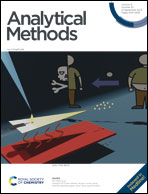Label-free dual-mode sensing platform based on target-regulated CRISPR–Cas12a activity for ochratoxin A in Morinda officinalis†
Abstract
Many traditional Chinese herbs are susceptible to ochratoxin A (OTA), a potent mycotoxin, which causes serious effects on the quality of the herb and on people's health. The development of methods to detect OTA is extremely important. Most methods for detecting OTA are based on a single-signal output mode, which might be easily influenced by complex environmental conditions. In this research, by taking advantage of the cleavage of DNA by target-induced CRISPR–Cas12a activity and the difference in electrostatic force of DNA to different charge electrochemiluminescent (ECL) and electrochemical (EC) probes, a biosensor is developed for the detection of OTA. First, the CRISPR–Cas12a system consists of a well-designed crRNA, its complementary strand (also as an aptamer for OTA), and Cas12a. Without the target, this CRISPR–Cas12a system is in the “activated stage”, which digests hairpin DNA on the electrode, resulting in a weak ECL signal and strong current response. With the introduction of OTA bound with the aptamer, CRISPR–Cas12a activity is inhibited (“locked stage”). Thus, hairpin DNA remained intact on the electrode, resulting in recovery of the ECL signal and attenuation of the current intensity. As a result, this label-free dual-mode sensing platform realizes an assay for OTA in Morinda officinalis. This target-regulated CRISPR–Cas12a activity-sensing platform with dual-mode output not only provides high sensitivity (due to the CRISPR–Cas12a system), but also has good anti-interference ability against complex substrates (due to dual-mode output), and exhibits a broad range of prospects for application.



 Please wait while we load your content...
Please wait while we load your content...